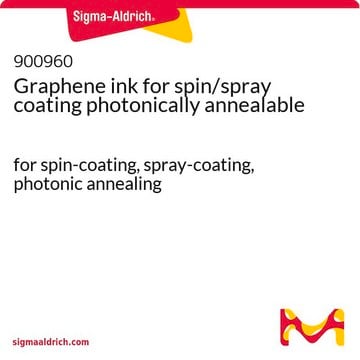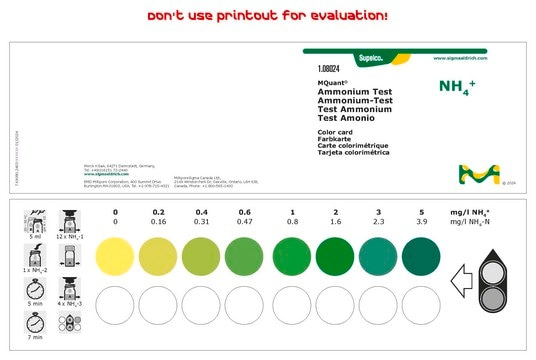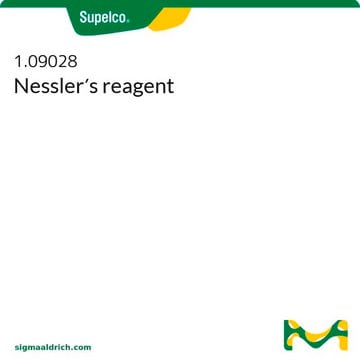The protocol below has not been tested but is based on adaptations of the reagents to similar instruments.
In order to perform the assay in a microplate instead of cuvettes, the reagent and sample volumes can be reduced by a factor of 5. Thus, the reagent volume would be 200 microliters; the volume of water or sample would be 20 microliters, and the volume of standard would be 10 microliters. The required volume of the enzyme solution would decrease to 2 microliters, which is difficult to pipette accurately. To deliver the enzyme more accurately, dilute it 5x P5244 using Phosphate Buffer, pH 7.5, as the enzyme diluent and pipette 10 microliters into each well.
Wichtige Dokumente
AA0100
Ammoniak-Assay-Kit
sufficient for 100 assays
Synonym(e):
Quantitatives Ammoniak-Testkit
Größe auswählen
About This Item
Empfohlene Produkte
Verwendung
sufficient for 100 assays
Lagertemp.
2-8°C
Anwendung
Nur Kit-Komponenten
- Ammonia Assay Reagent 10 vial(s)
- L-Glutamate Dehydrogenase for Ammonia Assay 1 mL/vial
- Ammonia Standard Solution 1 mL/vial
Signalwort
Danger
H-Sätze
Gefahreneinstufungen
Eye Irrit. 2 - Resp. Sens. 1
Lagerklassenschlüssel
10 - Combustible liquids
Flammpunkt (°F)
Not applicable
Flammpunkt (°C)
Not applicable
Hier finden Sie alle aktuellen Versionen:
Analysenzertifikate (COA)
Die passende Version wird nicht angezeigt?
Wenn Sie eine bestimmte Version benötigen, können Sie anhand der Lot- oder Chargennummer nach einem spezifischen Zertifikat suchen.
Besitzen Sie dieses Produkt bereits?
In der Dokumentenbibliothek finden Sie die Dokumentation zu den Produkten, die Sie kürzlich erworben haben.
Kunden haben sich ebenfalls angesehen
Artikel
Sigma article discusses tumor cell metabolic pathways, focusing on aerobic glycolysis and mitochondrial activity.
Fatty acid synthesis supports cancer cell proliferation, essential for membrane generation, protein modification, and bioenergetics.
-
Can we use this kit for microplate reader system
1 Antwort-
Hilfreich?
-
-
How is shipping temperature determined? And how is it related to the product storage temperature?
1 Antwort-
Products may be shipped at a different temperature than the recommended long-term storage temperature. If the product quality is sensitive to short-term exposure to conditions other than the recommended long-term storage, it will be shipped on wet or dry-ice. If the product quality is NOT affected by short-term exposure to conditions other than the recommended long-term storage, it will be shipped at ambient temperature. As shipping routes are configured for minimum transit times, shipping at ambient temperature helps control shipping costs for our customers. For more information, please refer to the Storage and Transport Conditions document: https://www.sigmaaldrich.com/deepweb/assets/sigmaaldrich/marketing/global/documents/316/622/storage-transport-conditions-mk.pdf
Hilfreich?
-
-
How can I determine the shelf life / expiration / retest date of this product?
1 Antwort-
If this product has an expiration or retest date, it will be shown on the Certificate of Analysis (COA, CofA). If there is no retest or expiration date listed on the product's COA, we do not have suitable stability data to determine a shelf life. For these products, the only date on the COA will be the release date; a retest, expiration, or use-by-date will not be displayed.
For all products, we recommend handling per defined conditions as printed in our product literature and website product descriptions. We recommend that products should be routinely inspected by customers to ensure they perform as expected.
For products without retest or expiration dates, our standard warranty of 1 year from the date of shipment is applicable.
For more information, please refer to the Product Dating Information document: https://www.sigmaaldrich.com/deepweb/assets/sigmaaldrich/marketing/global/documents/449/386/product-dating-information-mk.pdfHilfreich?
-
-
In the case of bacterial culture supernatant (BHI broth), should the decolorization process be performed? How?
1 Antwort-
Any sample solution that is strongly colored and/or has a low ammonia concentration should be decolorized when using this kit. Colored sample solutions often are treated with decolorizing carbon (activated charcoal) to remove color-contributing impurities.
Hilfreich?
-
-
Is there a control that can be used to assess the accuracy of Product AA0100, Ammonia Assay Kit?
1 Antwort-
A convenient control for use with this kit is the Ammonia Standard Solution that is provided in the kit.
Hilfreich?
-
-
How can I assess the absorbance change of my reagent blank when using Product AA0100, Ammonia Assay Kit?
1 Antwort-
Generally, an absorbance change of 0.050 or less indicates an acceptable range for the reagent blank. An absorbance change higher than this indicates possible contamination of the reagent (or glassware) with ammonia.
Hilfreich?
-
-
Which samples should be deproteinized for use with Product AA0100, Ammonia Assay Kit?
1 Antwort-
The basis for this kit was a Diagnostic procedure for the determination of Ammonia in human plasma, whose total protein concentration is approximately 63 to 83 mg/mL. Thus, any solution whose protein concentration is less than approximately 83 mg/mL should not require deproteinization.
Hilfreich?
-
-
What is the Department of Transportation shipping information for this product?
1 Antwort-
Transportation information can be found in Section 14 of the product's (M)SDS.To access the shipping information for this material, use the link on the product detail page for the product.
Hilfreich?
-
Aktive Filter
Unser Team von Wissenschaftlern verfügt über Erfahrung in allen Forschungsbereichen einschließlich Life Science, Materialwissenschaften, chemischer Synthese, Chromatographie, Analytik und vielen mehr..
Setzen Sie sich mit dem technischen Dienst in Verbindung.








